![]()
![]()
![]()
Use LEFT and RIGHT arrow keys to navigate between flashcards;
Use UP and DOWN arrow keys to flip the card;
H to show hint;
A reads text to speech;
56 Cards in this Set
- Front
- Back
|
the urease test and the SIM are important tests when trying to identify
|
Proteus mirabilis
|
|
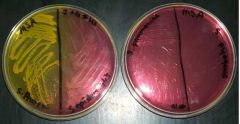
Mannitol Salt Agar (MSA)
|

both selective and differential
The MSA will select for organisms such as Staphylococcus species which can live in areas of high salt concentration The differential ingredient in MSA is the sugar mannitol. Organisms capable of using mannitol as a food source will produce acidic byproducts of fermentation that will lower the pH of the media (will turn yellow) |
|
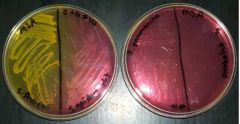
Mannitol Salt Agar (MSA)
selects for selects against |

Staphylococcus species which can live in areas of high salt concentration
Streptococcus species |
|
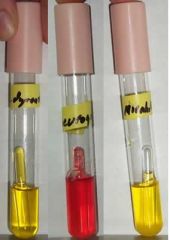
Glucose broth with Durham tubes
|

differential medium. It tests an organism's ability to ferment the sugar glucose as well as its ability to convert the end product of glycolysis, pyruvic acid into gaseous byproducts
|
|
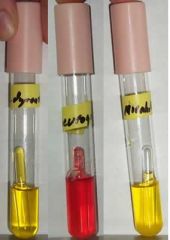
Glucose broth with Durham tubes is common test when
|

to identify Gram-negative enteric bacteria, all of which are glucose fermenters but only some of which produce gas
|
|

Glucose broth with Durham tubes
Eschericia coli Proteus mirabilis Shigella dysenteriae Pseudomonas aeruginosa |

Escherichia coli is capable of fermenting glucose.
Proteus mirabilis is capable of fermenting glucose. Shigella dysenteriae is capable of fermenting glucose. Pseudomonas aeruginosa is a nonfermenter. |
|
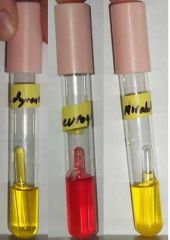
Glucose broth with Durham tubes
Escherichia coli Proteus mirabilis |

Organisms that are capable of converting pyruvate to formic acid and formic acid to H2 (g) and CO2 (g), via the action of the enzyme formic hydrogen lyase, emit gas. This gas is trapped in the Durham tube and appears as a bubble at the top of the tube.
Escherichia coli is a gas producer Proteus mirabilis is a gas producer |
|

Blood Agar Plates (BAP)
which plate is which hemolysis |

Beta-hemolysis is complete hemolysis. It is characterized by a clear (transparent) zone surrounding the colonies. Staphylococcus aureus, Streptococcus pyogenes and Streptococcus agalactiae are b-hemolytic (the picture on the left below shows the beta-hemolysis of S. pyogenes).
Partial hemolysis is termed alpha-hemolysis. Colonies typically are surrounded by a green, opaque zone. Streptococcus pneumoniae and Streptococcus mitis are a-hemolytic (the picture on the right below shows the a-hemolysis of S. mitis). If no hemolysis occurs, this is termed gamma-hemolysis. There are no notable zones around the colonies. Staphylococcus epidermidis is gamma-hemolytic. |
|

Staphylococcus aureus
Streptococcus pyogenes Streptococcus agalactiae Streptococcus pneumoniae Streptococcus mitis Staphylococcus epidermidis |

Beta-hemolysis
Staphylococcus aureus Streptococcus pyogenes Streptococcus agalactiae alpha-hemolysis Streptococcus pneumoniae Streptococcus mitis gamma-hemolysis Staphylococcus epidermidis |
|

Blood Agar Plates (BAP) tests for...
|

tests the ability of an organism to produce hemolysins, enzymes that damage/lyse red blood cells
|
|
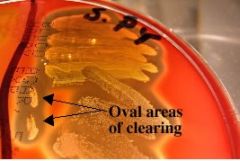
Streak-stab technique
|

Often when inoculating a BAP to observe hemoloysis patterns, investigators will also stab several times through the agar using an inoculating loop. This stab allows for the detection of streptolysin O, a specific hemolysin produced by Streptococcus pyogenes. This hemolysin is inactivated by O2 and is only seen subsurface (in an anaerobic environment) around the stab mark
|
|
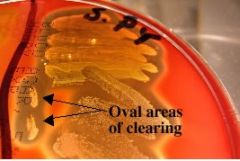
what does the stab streak test test for
|

allows for the detection of streptolysin O, a specific hemolysin produced by Streptococcus pyogenes.
|
|
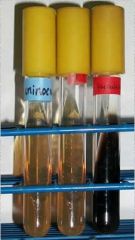
Bile Esculin Agar
|

selective and differential
tests the ability of organisms to hydrolyze esculin in the presence of bile If an organism can hydrolyze esculin in the presence of bile, the product esculetin is formed (causing agar to be black) |
|
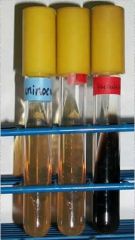
when is the Bile Esculin Agar test used
|

It is commonly used to identify members of the genus Enterococcus (E faecalis and E. faecium).
|
|
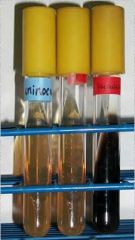
what does the bile select against
what does the sodium azide select against |

The first selective ingredient in this agar is bile, which inhibits the growth of Gram-positives other than enterococci and some streptococci species.
The second selective ingredient is sodium azide. This chemical inhibits the growth of Gram-negatives. |
|
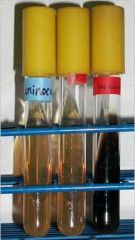
is E. faecalis positive on negative in the Bile Esculin Agar test
|

positive
|
|
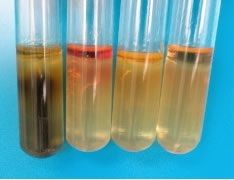
Sulfur Indole Motility Media (SIM)
|

differential medium
tests the ability of an organism to do several things: reduce sulfur, produce indole and swim through the agar (be motile). |
|
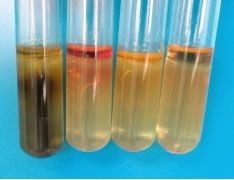
SIM is commonly used to differentiate members of
|

Enterobacteriaceae.
|
|
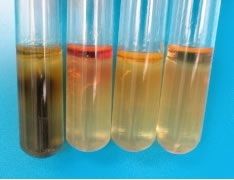
Sulfur Indole Motility Media (SIM)
Proteus mirabilis is positive for |

H2S production (turns agar black)
|
|
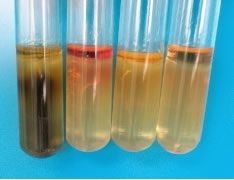
Escherichia coli is indole
|

positive (red ring)
|
|
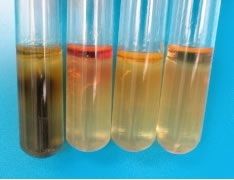
Pseudomonas aeruginosa and the strain of Proteus mirabilis that we work with are.
|

motile
|
|
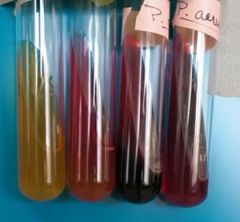
Kliger’s Iron Agar (KIA)
|

differential medium
tests for organisms’ abilities to ferment glucose and lactose to acid and acid plus gas end products. It also allows for identification of sulfur reducers |
|
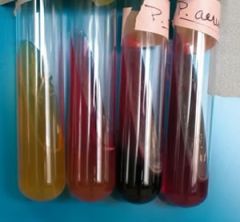
This media is commonly used to separate lactose fermenting members of the family______ from members that do not ferment lactose, like_______
|

Enterobacteriaceae (e.g. Escherichia coli)
Shigella dysenteriae |
|

The first differential ingredient, glucose, is in very short supply. Organisms capable of fermenting this sugar will use it up within the first few hours of incubation.
Glucose fermentation will create acidic byproducts that will turn the phenol red indicator in the media ____. Thus, after the first few hours of incubation, the tube will be entirely yellow. At this point, when the glucose has been all used up, the organism must choose another food source. If the organism can ferment lactose, this is the sugar it will choose. Lactose fermentation will continue to produce acidic byproducts and the media will remain ____ |
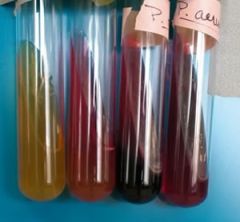
yelllow
yellow |
|
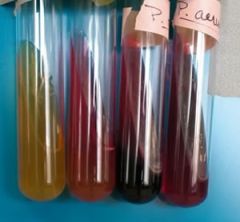
If an organism cannot use lactose as a food source it will be forced to use the amino acids / proteins in the media. The deamination of the amino acids creates NH3, a weak base, which causes the medium to become alkaline. The alkaline pH causes the phenol red indicator to begin to turn______. Since the incubation time is short (18-24 h), only the slant has a chance to turn red and not the entire tube. Thus an organism that can ferment glucose but not lactose, will produce a ______slant and a _____ butt in a KIA tube
|

red
red yellow |
|
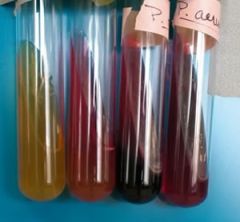
Kliger’s Iron Agar (KIA)
If an organism is capable of using neither glucose nor lactose, the organism will use solely amino acids / proteins. The slant of the tube will be _________ |

red and the color of the butt will remain unchanged
|
|
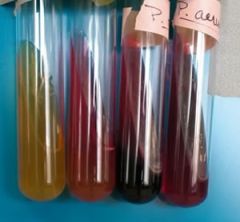
Kliger’s Iron Agar (KIA)
KIA tubes are also capable of detecting the production of H2S. It is seen as ______. Sometimes the black precipitate obscures the butt of the tube. In such cases, the organisms should be considered _______ |

a black precipitate
positive for glucose fermentation (yellow butt). |
|
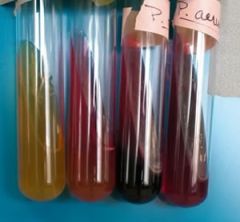
Kliger’s Iron Agar (KIA)
Thus an organism that can ferment glucose but not lactose, will produce a red slant and a yellow butt in a KIA tube (second from the left below). These organisms are the more serious pathogens of the GIT such as_____ |

Shigella dysenteriae
|
|
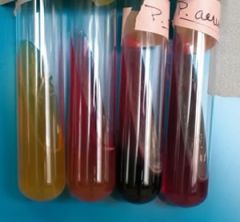
Kliger’s Iron Agar (KIA)
Proteus mirabilis_____ |

(pictured here, second from right) is a glucose positive, lactose negative, sulfur reducing enteric.
|
|
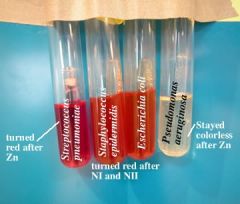
Nitrate Broth
|

differential medium
determine if an organism is capable of reducing nitrate (NO3-) to nitrite (NO2-) or other nitrogenous compounds via the action of the enzyme nitratase |
|
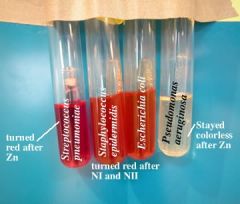
Nitrate Broth
what are positive results what are negative results |

positive is pink after nitrate I and II
Or no color change after nitrate I and II and Zinc negative is pink after zinc |
|
|
Catalase Test
|
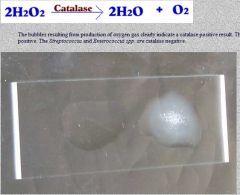
enough said
|
|
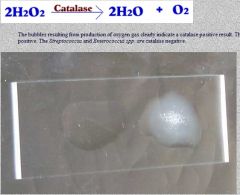
The Staphylococcus spp. and the Micrococcus spp. are catalase _____
The Streptococcus and Enterococcus spp. are catalase ______ |

positive.
negative. |
|
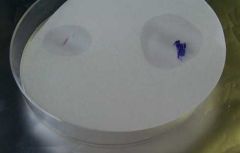
Oxidase Test
|

This test is used to identify microorganisms containing the enzyme cytochrome oxidase (important in the electron transport chain).
|
|

Oxidase Test
commonly used to distinguish between oxidase negative _____ and oxidase positive ______ |
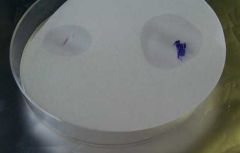
Enterobacteriaceae
Pseudomadaceae. |
|
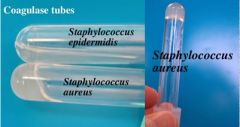
Coagulase test
This test is performed on Gram-positive, catalase positive species to identify the coagulase positive |

Staphylococcus aureus
|
|
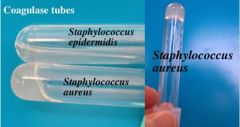
Coagulase test
This test differentiates _____ from other coagulase negative ______ |

Staphylococcus aureus
Staphylococcus species |
|
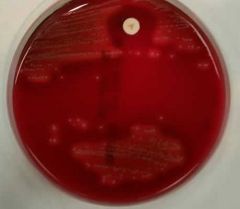
Taxos A (bacitracin sensitivity testing)
|

This is a differential test used to distinguish between organisms sensitive to the antibiotic bacitracin and those not. Bacitracin is a peptide antibiotic produced by Bacillus subtilis
|
|
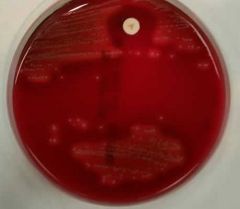
This test is commonly used to distinguish between the b-hemolytic streptococci:_______ and _______
|

Streptococcus agalactiae (bacitracin resistant)
Streptococcus pyogenes (bacitracin sensitive). |
|

Taxos P (optochin sensitivity testing)
|

This is a differential test used to distinguish between organisms sensitive to the antibiotic optochin and those not.
|
|

Taxos P (optochin sensitivity testing)
This test is used to distinguish ____ from other a-hemolytic ____ |

Streptococcus pneumoniae (optochin sensitive
streptococci (optochin resistant |
|

MacConkey agar
|

selective and differential. The selective ingredients are the bile salts and the dye, crystal violet which inhibit the growth of Gram-positive bacteria. The differential ingredient is lactose. Fermentation of this sugar results in an acidic pH and causes the pH indicator, neutral red, to turn a bright pinky-red color
|
|

organisms capable of lactose fermentation such as____ , form bright pinky-red colonies
|

Escherichia coli
|
|

MacConkey agar is commonly used to differentiate between the _____
|

Enterobacteriaceae
|
|
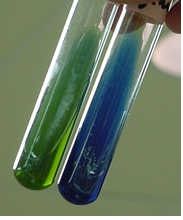
Simmon’s Citrate Agar
|

defined medium used to determine if an organism can use citrate as its sole carbon source
|
|
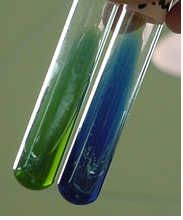
Simmon’s Citrate Agar
is often used to differentiate between members of _____ |

Enterobacteriaceae
|
|
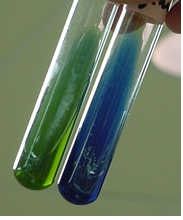
Simmon’s Citrate Agar
Klebsiella pneumoniae and Proteus mirabilis are examples of citrate _____organisms. Escherichia coli and Shigella dysenteriae are citrate ____ |

positive (blue agar)
negative. (remains green) |
|

Spirit Blue agar
|
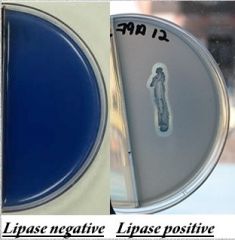
used to identify organisms that are capable of producing the enzyme lipase
|
|
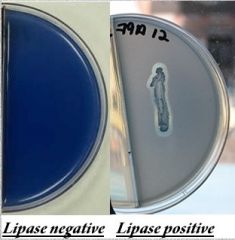
Spirit Blue agar
how it works |

Spirit blue agar contains an emulsion of olive oil and spirit blue dye. Bacteria that produce lipase will hydrolyze the olive oil and produce a halo around the bacterial growth
|
|
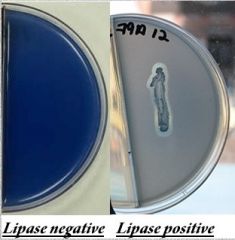
The Gram-positive rod, _____ is lipase positive
|

Bacillus subtilis
|
|
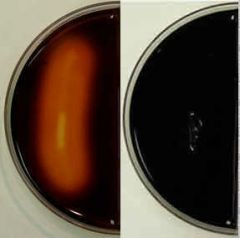
Starch hydrolysis test
|

This test is used to identify bacteria that can hydrolyze starch (amylose and amylopectin) using the enzymes a-amylase and oligo-1,6-glucosidase
|
|

Starch hydrolysis test
Often used to differentiate species from the genera ______ |
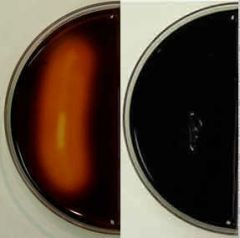
Clostridium and Bacillus (
Bacillus is postive) |
|
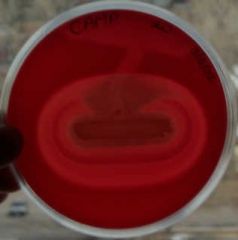
CAMP Test
CAMP factor is a diffusible, heat-stable protein produced by group B streptococci. This is a synergistic test between _____ and ______ |

Staphylococcus aureus
Streptococcus agalactiae |
|
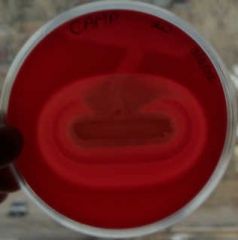
CAMP Test
S. agalactiae produces CAMP factor. S. aureus produces sphingomyelin C, which binds to red blood cell membranes. The two bacteria are streaked at 90 degree angles of one another. They do NOT touch. The CAMP factor produced by S. agalactiae enhances the beta-hemolysis of S. aureus by binding to already damaged red blood cells. As a result, an arrow of beta-hemolysis is produced between the two streaks. The test is presumptive for _____ that produces CAMP factor. |

S. agalactiae
|
|

Urease test
|
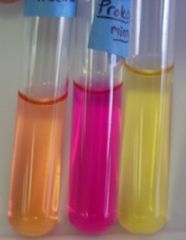
This test is used to identify bacteria capable of hydrolyzing urea using the enzyme urease
pink is positive |
|
|
which bacteria is streptolysine O positive
|
streptococcus pyogenes
|

